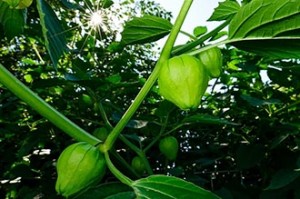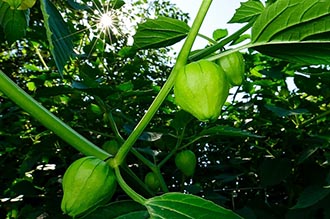(Author: Liz Beyler; Copyright by and reproduced with permission from the University of Wisconsin, Madison, WI)

By now, you may have noticed the lush vegetable garden beds outside the wrought iron fence surrounding Allen Centennial Gardens at Observatory and Babcock drives.
A little white sign tucked in between the plants offers passersby this invitation:
“Need a snack? Come over and have a bite. We’re showing space-saving ideas for vegetable patches and showing that veggies can be pretty and yummy. Go ahead and munch on a tomato as you wait for the bus!”
As vegetables ripen, it’s a tempting invitation.
“We are inviting people to pick from the produce growing outside the fence to encourage them to see what fresh locally grown food tastes like and to come inside the fence to look at the rest of what we have growing,” says garden director Ed Lyon.
“It’s part of our focus on expanding our educational efforts about growing fresh produce in limited spaces and in areas that are not being used effectively otherwise,” says Lyon. He refers to it as “sort of a version of front-lawn gardening.”
There is a large variety of produce growing in the streetside gardens. Among them are tomatoes, leeks, squash, cucumbers, colorful chard, kale, beets, various peppers, including jalapenos and more. Many of them aren’t quite ready for harvesting yet.
In the beds along Babcock Drive there are lots of tomato plants that are supported in various ways, from the traditional single stake to mesh trellises, round and square cages, bamboo and metal supports.
“We are also trying to demonstrate ways of growing vegetables more vertically with the various structures you see outside and inside the gardens,” says Lyon, noting that there are several support systems that demonstrate how it can be done.
Visitors who don’t have much room in which to dig up and create a garden bed at home will learn how produce can be grown in mesh potato and tomato bags.
He says the soils were very poor and compacted in the areas adjoining the street, so five yards of compost were added to the two street-side beds.
There is another little note at ground level that explains that the food is grown organically and fertilized with compost “tea” made from worm castings.
“So far things seem to be growing well,” says Lyon, adding that edible-based plants still appear in areas of the gardens other than in the herb and kitchen gardens.
“We created a semi-circular swath along the large circular lawn garden. We planted two columnar forms of basil – “Pesto Perpetuo” and “Greek Columnar,” as well as “Bull’s Blood” purple beets and “Rainbow” chard with a scattering of thyme and other basils,” says Lyon.
“Every bit of the hedge is edible, but you have to look at it closely to recognize that these are herbs and vegetables, not ornamental plants,” he adds.
The fresh produce grown in the garden, other than that which visitors decide to sample, will go to University Housing’s Dining and Culinary Services for use in Frank’s Place at Holt Commons. The partnership with Housing began in 2009.
This year’s theme at Allen Gardens is “Color Your World,” and Lyon says it has been drawing considerable attention. It is designed to teach visitors about garden color terminology.
In separate beds visitors will find contrasting colors, colors by foliage, the importance of texture, warm colors, cool colors, pastel impressionistic colors, and the use of silver and white as fillers. A color wheel is represented in large pots on the terrace, and there are matching obelisks and painted chairs.

